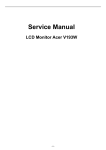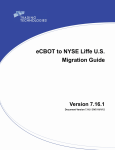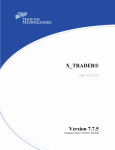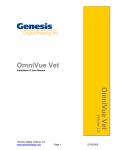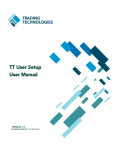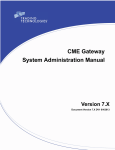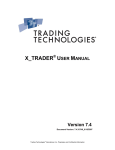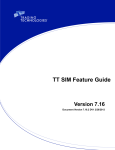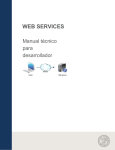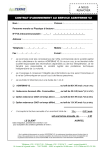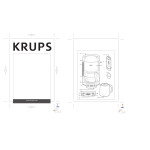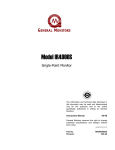Download NYSE Liffe to ICE Migration Guide
Transcript
NYSE Liffe to ICE Migration Guide Version 7.X Document Version 7.17.0DV3 10/2/2014 This document and all related computer programs, example programs, and all TT source code are the exclusive property of Trading Technologies International, Inc. (“TT”), and are protected by licensing agreements, copyright law and international treaties. Unauthorized possession, reproduction, duplication, or dissemination of this document, or any portion of it, is illegal and may result in severe civil and criminal penalties. Unauthorized reproduction of any TT software or proprietary information may result in severe civil and criminal penalties, and will be prosecuted to the maximum extent possible under the law. Information in this document is subject to change without notice. Companies, names, and data used in examples herein are fictitious unless otherwise noted. No part of this document may be reproduced or transmitted in any form or by any means, electronic or mechanical, for any purpose, without the express written permission of TT. All trademarks displayed in this document are subject to the trademark rights of TT, or are used under agreement by TT. These trademarks include, but are not limited to, service brand names, slogans and logos and emblems including but not limited to: Trading Technologies®, the Trading Technologies Logo, TT™, X_TRADER®, X_RISK®, MD Trader®, Autospreader®, X_STUDY®, TT_TRADER®, TT CVD®, ADL®, Autotrader™, TT Trainer™, Back Office Bridge™, TTNET™. All other referenced companies, individuals and trademarks retain their rights. All trademarks are the property of their respective owners. The unauthorized use of any trademark displayed in this document is strictly prohibited. Copyright © 2014 Trading Technologies International, Inc. All rights reserved. 1 Legal Version History: This section tracks all changes to this Migration Guide. Version 1 Initial Version Version 2 Added note about implieds for migrated contracts, FMDS and RTD changes for new spread names. Version 3 Added FMDS and RTD changes for new spread names. Copyright © 2014 Trading Technologies International, Inc. All rights reserved. iii Trading Technologies International, Inc. 1 Planning a NYSE Liffe to ICE Migration Overview Before You Begin Following the acquisition of Liffe by the InterContinental Exchange (ICE), all currently tradable products on the NYSE Liffe Gateway will be available for trade via TT’s ICE Gateway 7.17.60. Note: This migration does not include Euronext products. Use this document to plan a migration from trading NYSE Liffe products via a NYSE Liffe Gateway to leveraging the new ICE Gateway. This document addresses the following scenarios: • NYSE Liffe and ICE Gateway users: includes any firm that currently trades NYSE Liffe and ICE. • NYSE Liffe Gateway only users: includes any firm that trades NYSE Liffe and does not currently have an ICE Gateway installed in their trading environment. Both types of users perform similar migration steps, however, NYSE Liffe-only users may also convert an existing server that hosts a NYSE Liffe Gateway to hosting an ICE Gateway. Note: Before proceeding, contact your Technical Account Manager (TAM) regarding your plans to migrate to new ICE Gateways and coordinate any migration issues that are unique to your trading environment. Who is the intended audience for this guide? The intended audience is end-users (e.g., traders, brokers) and administrators (e.g., risk administrators, gateway/server administrators, etc.), and the guide includes separate chapters for both audiences. For end-users, refer to the NYSE Liffe to ICE End User Guide. What are the benefits of migrating to the ICE Gateway? This version now allows trading all products (except Euronext) available from Liffe via a single ICE Gateway. What are the differences in behavior between the current NYSE Liffe Gateway and ICE Gateway 7.17.60? Note the following differences when migrating to the new ICE Gateway: • For TT Clients, an updated implied.cfg file is required for trading the new ICE Gateway. • Cabinet trades are supported. Refer to the ICE Functionality matrix on the exchange website. • The open/close indicator (O/C) is supported when submitting orders on the new ICE Gateway. • Minimum Volume order type is not supported by the ICE exchange • Market GTC, IOC, and FOK are not supported by the ICE exchange. • Wholesale order support for Liffe products is not supported in the current version of X_TRADER and the ICE Gateway. TT will be releasing new versions to support wholesale trades. NYSE Liffe to ICE Migration Guide Trading Technologies International, Inc. 4 1 Planning a NYSE Liffe/ICE Gateway Migration When should I migrate? The exchange will leverage a phased-migration of products in the upcoming weeks. However, you may complete nearly all of the tasks listed in this document prior to the exchange’s migration. Note: The migration tasks should be completed at a time that is best for your particular trading environment. TT recommends that you perform migration steps during non-trading hours. Do I need to order lines or change my connectivity options? Following the migration, users must utilize a separate fix session and trader ID for each market (e.g., one for Liffe and a separate fix section for ICE). Two sessions are required if you plan to trade Liffe and ICE; a single session cannot be used for trading both exchanges. Users may establish a co-located presence in either the existing NYSE Liffe Basildon datacenter or the current ICE datacenter based in Chicago. The facilitates will offer access to the following: Co-Location (Basildon) The datacenter located in Basildon will provide access to the following markets: • Access to Euronext markets hosted in Basildon • Access to LIFFE markets (on ICE platform) hosted in Basildon • Access to ICE platform and markets hosted in Chicago • SFTI will provide access to ICE platform in Chicago and Basildon (plus DR locations) as well as Euronext markets. Co-Location (Chicago) The ICE Network will provide access from all regional hubs to the ICE platform in Basildon (LIFFE) and Chicago (plus DR locations). Note: Access to the Euronext platform will not be provided via the ICE Network. NYSE Liffe to ICE Migration Guide Trading Technologies International, Inc. 5 1 Planning a NYSE Liffe/ICE Gateway Migration What is the timetable for the migration? Contracts will migrate from Liffe to ICE in the following Tranches: Date Task September 27-29 To accurately record data for Liffe Commodities, users must update their FMDS database between the end of trading on Friday, September 27 and the start of trading on Monday, September 29, 2014. September 29, 2014 The exchange migrates Liffe Soft Commodities contracts in EU Tranche 1. October 3-6 To accurately record data for Liffe products in EU Tranche 2, users must update their FMDS database between the end of trading on Friday, October 3rd and the start of trading on Monday, October 6th 2014. October 6, 2014 The exchange migrates Liffe Fixed Income contracts (Part 1) in EU Tranche 2 October 17-20 To accurately record data for Liffe EU Tranche 3 products, users must update their FMDS database between the end of trading on Friday, October 17 and the start of trading on Monday, October 20, 2014. October 20, 2014 The exchange migrates Liffe Fixed Income contracts (Part 2) in EU Tranche 3 October 31November 3 To accurately record data for Liffe EU Tranche 4 products, users must update their FMDS database between the end of trading on Friday, October 31 and the start of trading on Monday, November 3, 2014. November 3, 2014 The exchange migrates Liffe Fixed Income contracts (Part 3) in EU Tranche 4 November 13th-14th To accurately record data for Liffe equity products, users must update their FMDS database between the end of trading on Thursday, November 13 and the start of trading on Friday, November 14, 2014. November 17, 2014 The exchange migrates Liffe Equity contracts in EU Tranche 5. November 17, 2014 and later Users may delete their NYSE Liffe Gateway logins from TT User Setup. Table 1. Timetable Note: For the latest list of contracts in each Tranche, refer to: https:// www.theice.com/publicdocs/circulars/14102.pdf NYSE Liffe to ICE Migration Guide Trading Technologies International, Inc. 6 1 Planning a NYSE Liffe/ICE Gateway Migration How do I prepare my TT Trading Environment? Can I upgrade an existing ICE Gateway? You can upgrade an existing ICE Gateway to the new version by running the installation package on the same server that currently hosts your ICE Gateway. TT does not support upgrading a NYSE Liffe Gateway to a new ICE Gateway. To install the new ICE Gateway on a server machine that currently hosts a NYSE Liffe Gateway, you must uninstall the existing gateway. What version of the ICE Gateway should I use? All users should migrate to ICE Gateway 7.17.60, which will be available by contacting your TAM. For information on installing and configuring a ICE Gateway, refer to the ICE Gateway online help. What are the minimum supported versions of TT Client applications? All TT Trading Applications that connect to the ICE Gateway must meet the minimum version requirements listed below: Application X_TRADER Minimum Version 7.11.4 7.17.35 for implied prices; 7.17.46 for wholesale trades X_TRADER API 7.7.x TTAPI 7.2.x X_RISK 7.11.4 TT User Setup 7.4.12 FIX Adapter 7.7.x Algo SE 7.3.x Synthetic SE 7.3.x Autospreader SE 7.3.x Table 2. Recommended Client Applications NYSE Liffe to ICE Migration Guide Trading Technologies International, Inc. 7 1 Planning a NYSE Liffe/ICE Gateway Migration What is the optimal ICE Gateway deployment to trade both ICE and Liffe products? In order to trade ICE U.S. products as well as the Liffe products being migrated to the ICE platform, customers will need separate TT ICE Gateways. As a result, customers will need separate price session credentials from the exchange in order to receive market data for ICE and Liffe products on two separate ICE Gateway Price Servers. To ensure proximity to the exchange matching engines and reduce latency, TT recommends that customers deploy their TT ICE Gateways in the datacenters closest to where order matching occurs. For ICE U.S. products, this location is Chicago; for Liffe products migrated to the ICE platform, the location is London. Because of the need to separate the U.S. and London products, different gateway flavors are deployed. However, with X_TRADER 7.17 or higher, end-users only need to select the market-based “ICE Gateway” when submitting orders for both ICE and Liffe products and do not need to manually select customer defaults or use aliases to select the correct gateway for the products they are trading. TTNET, for example, is currently configured to provide the optimal solution for trading both products. The following diagram illustrates an example of an optimal ICE Gateway deployment: Note: If you combine or have overlapping Liffe and ICE U.S. products on one gateway, you will need separate sessions configured for both, and your end-users (using X_TRADER 7.17) will have to manually select an order routing session based on the products they are trading. Using TT User Setup, you will need to configure aliases or customer defaults for these end-users’ Gateway Logins in order to allow them to select the correct order session. NYSE Liffe to ICE Migration Guide Trading Technologies International, Inc. 8 1 Planning a NYSE Liffe/ICE Gateway Migration What is the Impact to Trader Identification? Can I use my existing credentials on the new ICE Gateway? For Tranche 1 (Soft Commodities products), Current ICE users may continue to use their existing connection credentials to trade both ICE and NYSE Liffe products on the new ICE Gateway. However, this process requires additional manual steps to properly migrate product limits to the existing credentials. Therefore, TT strongly recommends existing ICE users obtain additional credentials for trading NYSE Liffe products on ICE Gateways. For Tranches 2 through 5 (all other NYSE Liffe products moving to ICE), new ICE exchange credentials are required to trade these products on the new ICE Gateway. For more information on migrating product limits, refer to the section called How do I migrate product limits? on page 24. The new ICE Gateway does not leverage Individual Trader Mnemonics (ITMs). Current NYSE Liffe Gateway users that do not also trade ICE must request new connection credentials from the exchange. Can traders continue to share order books on the ICE Gateways? After correctly mapping trader IDs in TT User Setup, you can configure the Order Server on the new gateway to support order book sharing. Can traders use existing MGTs on the ICE Gateway? For Tranche 1 (Soft Commodities products), ICE Gateway Member-Group-Trader (MGT) logins can be used on the new ICE Gateway. Additionally, risk must be migrated and/or reassigned to users in TT User Setup 7.4.12 or higher. For Tranches 2 through 5 (all other NYSE Liffe products moving to ICE), new ICE Gateway logins are required for trading these products. For all Tranches, any existing NYSE Liffe TTORD IDs must be correctly mapped to the new ICE Gateway login MGTs in TT User Setup. Can I use SMA/LMA for new trader credentials? The exchange requests that new credentials leverage SMA (System Managed Accounts). For information on configuring SMA on ICE Gateways, refer to the ICE Gateway Help: https://www.tradingtechnologies.com/help/ice-gateway/configuring-accountmanagement-and-lma-support/ In addition, X_TRADER users must adhere to specific requirements when submitting orders via System Managed Accounts as described in the Configuring SMA section in the link below: https://www.tradingtechnologies.com/help/ice-gateway/configuring-accountmanagement-and-lma-support/#Configuring_SMA NYSE Liffe to ICE Migration Guide Trading Technologies International, Inc. 9 1 Planning a NYSE Liffe/ICE Gateway Migration What is the Licensing and Billing Impact? Can I reuse my current ICE Gateway licenses? Users may continue to use existing ICE Gateway licenses during and after the migration. Normal cancellation periods will be waived for NYSE Liffe Gateway licenses, so they can be canceled immediately upon request. Note: TT wishes to remind customers to submit license cancellations via the TT Customer Portal for NYSE Liffe Gateways that are no longer in use following the migration. TT will not automatically cancel any licenses. For a description of TT licensing, refer to the TT Gateway Architecture System Administration Manual Version 7.X. X_TRADER® and X_RISK® Licenses X_TRADER® and X_RISK® licenses are market-based. As part of the migration, users are required to verify that the ICE market appears in their X_TRADER® and X_RISK® licenses in order to log in to the ICE Gateway. During migration, you must have a license that accounts for the number of markets you wish to trade (e.g., one for NYSE Liffe, one for NYSE Liffe and another for ICE). Following the migration, users will require a single license for all products available on the ICE Gateway. Users who wish to continue trading Euronext will require a separate NYSE Liffe license. If, as a result of this migration, customers need to reduce the number of markets accessible via X_TRADER® or X_RISK®, they must explicitly request that consolidation via the TT Customer Portal. TT will not automatically reduce the number of X_TRADER or X_RISK market licenses. Billing Server Impact There is no impact on the TT Transaction Billing Server. After the migration, fills and billing packets will continue to be recorded and transferred daily to the TT Licensing Department Accounting and Billing System and will contain the Exchange ID of the newly installed ICE Gateway. The TT Licensing and Accounting Department will be notified by your TAM that the new gateway is installed and the exchange IDs have changed. NYSE Liffe to ICE Migration Guide Trading Technologies International, Inc. 10 1 Planning a NYSE Liffe/ICE Gateway Migration Migration Checklists Overview The following checklists show the chronological steps for a successful migration to the ICE Gateway. Pre-Migration Checklist You should complete the items below to prepare for migrating gateways. Check Pre-Migration Task Procedure Obtain required TT Software licenses Obtain new ICE Gateway licenses for each new or upgraded gateway. Refer to What is the Licensing and Billing Impact?. Upgrade all client applications Refer to What are the minimum supported versions of TT Client applications? Table 3. Pre-Migration Checklist NYSE Liffe to ICE Migration Guide Trading Technologies International, Inc. 11 1 Planning a NYSE Liffe/ICE Gateway Migration Migration Checklist Check The following tasks should be performed during non-trading hours. Ideally, you should begin these steps following the close of the last trading day prior to migration and complete them over the course of the subsequent weekend. Migration Task Procedures Prepare X_TRADER® for migration Delete all working orders from the exchange Create new ICE workspaces Refer to What is the X_TRADER® Impact? Prepare X_TRADER® plug-ins for use with the ICE Gateway Prepare trader logins for migration Refer to What is the impact to X_TRADER® Plug-ins? Configure new Direct Trader IDs Configure TTORD Trader IDs Add any new/additional Trader IDs Refer to How Do I Migrate Traders in TT User Setup? Prepare trader positions Enter existing trader positions If enabled on the current gateway, enable the Auto-CalculateSOD functionality on the new ICE Gateway Refer to Can I migrate existing trader positions? Prepare FIX Adapter for migration Refer to How does this migration impact existing FIX Adapter users? Prepare X_RISK for use with the ICE Gateway Add ICE Gateway logins Update the Historical Fill Server database Refer to What is the X_RISK Impact? Migrate the existing gateway to a ICE Gateway Refer to What is the TT Gateway Impact? Reconfigure any Strategy Engines Refer to What is the impact to Strategy Engines (SEs) connected to the new ICE Gateway? Table 4. Migration Checklist NYSE Liffe to ICE Migration Guide Trading Technologies International, Inc. 12 2 End User Guide: NYSE Liffe to ICE How are end users impacted by the product migration? What version of X_TRADER® should I use? What products are being migrated to ICE and when? ICE Gateways require a minimum of X_TRADER® Version 7.11.4 for basic trading functionality and 7.17.46 to support wholesale trading. Note: The ICE Exchange is not supporting Stop order types for Liffe products migrated to the ICE platform. ICE plans to offer Stop support at a later date. However, until then, customers who want to work Stops for the Liffe products migrated to ICE will have to use Synthetic SE and the X_TRADER® Override Native setting. Liffe exchange contracts will migrate to the ICE trading platform in phases (tranches) as shown in the table below. Tranche Contracts Date Primary Data Center DR Data Center 1 Soft Commodities September 29, 2014 Chicago Atlanta 2 Fixed Income, Part 1 October 6, 2014 Basildon Chicago 3 Fixed Income, Part 2 October 20, 2014 Basildon Chicago 4 Fixed Income, Part 3 November 3, 2014 Basildon Chicago 5 Equities November 17, 2014 Basildon Chicago Table 5. Liffe Product Migration Note: For the latest list of contracts in each Tranche, refer to: https:// www.theice.com/publicdocs/circulars/14102.pdf TT’s advisory for the migration is provided located at: https:// www.tradingtechnologies.com/support/advisories/2014/03/NI021-14/ Can I use my existing workspaces? ICE Workspaces Yes. If you’re an ICE trader, you can continue using your existing workspace to trade ICE products on the new ICE Gateway. NYSE Liffe Workspaces No. If you’ve been trading NYSE Liffe products, you will have to create a new workspace. Even though the same NYSE Liffe products can be traded (the product symbols in X_TRADER® are the same), the series keys are different on the ICE Gateway. If you try to open an old workspace with NYSE Liffe products on the new ICE Gateway, the contracts in the old workspace will not resolve correctly. For the steps to create a workspace in X_TRADER®, refer to: https:// www.tradingtechnologies.com/help/xtrader/creating-a-workspace/ NYSE Liffe to ICE Migration: End User Guide Trading Technologies International, Inc. 13 2 End User Guide: NYSE Liffe to ICE How do I manage working orders during migration? Prior to migration, traders must cancel all working orders, including GTC, GTD, and GTDate orders entered for NYSE Liffe products. Traders do not need to delete orders entered for ICE products. NYSE Liffe to ICE Migration: End User Guide Trading Technologies International, Inc. 14 2 End User Guide: NYSE Liffe to ICE What is the impact to Implied Prices? Are there any configuration changes needed to support implied prices? Yes, users with older versions of X_TRADER® (7.17.30 or lower) will need to apply a new impliedconfig.cfg file to their workstations in order to generate implied prices on exchange-defined futures strategies. In addition, this new impliedconfig.cfg must be applied to all Strategy Engine servers (Synthetic SE, Algo SE, Autospreader® SE) in the customer’s trading environment. X_TRADER 7.17.35 and higher includes a version of the file that is fully compatible with NYSE Liffe products available on the ICE Gateway. All users on older versions of X_TRADER must use the following procedure to update their local impliedconfig.cfg file. Note: By September 29, 2014, all X_TRADER workstation and Strategy Engines (SEs) require installation of the new impliedconfig.cfg file. You may perform the following procedure anytime before the product migration begins. To update the impliedconfig.cfg file: 1. Obtain a copy of the updated impliedconfig.cfg file from the TT Download Center. 2. Shutdown X_TRADER. 3. Add the updated file to the <root drive>:\TT\config directory to overwrite the existing file. 4. Restart X_TRADER. Warning: You must verify that all X_TRADER workstations, Synthetic Strategy Engines, Algo Strategy Engines, and Autospreader Strategy Engines in your environment use the updated impliedconfig.cfg file. To apply the file to an SE, refer your administrator to . What products in the impliedconfig.cfg are different between the old version and the new version? The following products have been added to the new version of the impliedconfig.cfg file: ASE,ASN,AWE,AWN,C,ED,EO3,EON,G,GDF,H,I,J,JGB,L,MAW,MCE,MCL,MCU,MEU,M FS,MFU,MGE,MLE,MME,MMN,MMW,MPP,MPU,MRG,MUN,MWL,O,P,R,RC,RPA,RPM,R PT,S,T,TWS,U,USP,USW,W,YG,YI,Z,ZG,ZI Note: X_TRADER cannot calculate implieds for the top months of the I (Euribor) contract or the first three contracts of any user defined spreads, including Butterflies and Condors. A future version of X_TRADER will support implieds for these contracts. NYSE Liffe to ICE Migration: End User Guide Trading Technologies International, Inc. 15 2 End User Guide: NYSE Liffe to ICE What is the impact to X_TRADER® Plug-ins? Is there impact to RTD? Existing links to RTD spreadsheets that reference the ICE Gateway will continue to function with the new ICE Gateway. Links that reference the NYSE Liffe Gateway must be updated to map to the new ICE Gateway. ICE Gateway 7.17.60 supports renamed ICE spread contracts. After upgrading to 7.17.60, traders that use RTD links and trade the renamed contracts via ICE will need to do the following: • Contact your TAM to assist you in updating links with the new spread contract names (an RTDTool is available to rename the contracts). • Ensure that Excel is installed on the client workstation. For more information regarding entering RTD formulas, refer to the XTAPI RTD Tutorial. What is the Impact to X_STUDY®? You can begin charting data from the new ICE Gateway following the migration however, you will not have access to the existing historical NYSE Liffe charts. Users will have access to historical charts for current ICE products. NYSE Liffe to ICE Migration: End User Guide Trading Technologies International, Inc. 16 2 End User Guide: NYSE Liffe to ICE What is the Impact to Algo Design Lab (ADL)? What is the impact to existing algo templates? You should not experience any differences to algo templates that contain ICE products. For algo templates that contain NYSE Liffe products, the following is true: How does this affect ‘persisted’ algo templates? • If the Algo Definitions deployed before the migration contain any static Instrument Blocks pointing to affected instruments (i.e., NYSE Liffe instruments): you must update the templates with valid instruments and re-deploy. This means that any linked Algo Templates will need to be rebuilt. • If the Algo Definitions deployed before the migration had user-defined Instrument Blocks: Any linked Algo Templates that were using affected Instruments will need to be updated. The information above applies to all affected algo templates. NYSE Liffe to ICE Migration: End User Guide Trading Technologies International, Inc. 17 3 Administrator Guide: NYSE Liffe to ICE How Do I Migrate NYSE Liffe Gateway Traders in TT User Setup? Can traders use their existing trader IDs on the new ICE Gateway? Traders can user their existing trader IDs only for Liffe’s Tranche 1 (Soft Commodities) products, which migrate on September 29, 2014. All other Liffe products migrating to the ICE platform require new ICE exchange credentials. ICE Trader ID Impact For Tranche 1 (Soft Commodities) products, users in your trading environment can maintain existing ICE trader IDs without any changes in TT User Setup and/or the hostinfo.cfg file on the ICE Gateway. NYSE Liffe Trader ID Impact For Tranche 1 (Soft Commodities) products, consider the following scenarios to determine which steps to take in TT User Setup. • NYSE Liffe and ICE Gateway users: includes any firm that currently trades Liffe and ICE. In this scenario, do the following to allow users to continue trading Liffe products via their existing ICE sessions after the Liffe products are migrated: • a Contact ICE prior to the first trading session after the Liffe products are migrated to ensure that users’ ICE session credentials are enabled for Liffe products. b In TT User Setup, move TTORDs from the NYSE Liffe Gateway direct trader logins and map them to the ICE Gateway direct trader logins. c Copy product limits from the NYSE Liffe Gateway to the ICE Gateway. NYSE Liffe Gateway only users: includes any firm that trades Liffe and does not currently have an ICE Gateway installed in their trading environment. In this scenario, do the following: a Ensure that the new ICE session credentials are configured on the ICE Gateway. b In TT User Setup, migrate users’ NYSE Liffe Gateway direct trader logins to the new ICE Gateway and assign it to users. Note: The Member value of the MemberGroupTrader login concatenation must match the Member parameter value specified in the [OrderSession#] section in the new ICE Gateway hostinfo.cfg file. Also, update the MGT with the new ICE credentials. NYSE Liffe to ICE Migration Guide Trading Technologies International, Inc. c In TT User Setup, move TTORDs from the NYSE Liffe Gateway direct trader logins and map them to the ICE Gateway direct trader logins. d Copy product limits from the NYSE Liffe Gateway to the ICE Gateway for the migrated TTORDs. 18 3 Administrator Guide: NYSE Liffe to ICE For Tranches 2 through 5 (all other Liffe products being migrated), what is the impact to risk and user setup? For Tranches 2 through 5 (all other Liffe products moving to ICE), you need to do the following: • Request the following new ICE exchange credentials: - trader IDs - FIX session IDs - FIX session passwords - Price session IDs for both Price Servers in your environment: one for ICE U.S. products and one for Liffe products. Users should work with the exchange to obtain new credentials for trading Liffe products on the new ICE Gateway. This allows users to easily migrate existing product limits to the new ICE Gateway. • Create new order sessions on the new ICE Gateway for Liffe products and configure Operator IDs. Refer to the ICE Gateway Help and the All Gateways Help. • Configure X_TRADER® Customer Defaults based on whether SMA or LMA accounts are used by the new ICE trader IDs. If you have existing Customer Defaults in TT User Setup or X_TRADER that are configured for the NYSE market, those customer defaults will need to be updated for the ICE market. For Tranche 1 (Soft Commodities) products, how do I migrate users’ NYSE Liffe direct trader logins to ICE? • Create new ICE Gateway direct trader logins with the new ICE credentials in TT User Setup. • Map TTORD gateway logins to the new ICE direct trader gateway logins in TT User Setup. • For each migrated product, migrate product limits to the new ICE Gateway logins in TT User Setup. Note: Perform this procedure if you need to add new ICE Gateway direct trader logins. Use this procedure to migrate NYSE Liffe gateway logins to an ICE Gateway. Make sure to update the migrated direct trader MGTs with the new ICE credentials obtained from the exchange. The following procedure also copies the NYSE Liffe direct trader product limits to the new ICE Gateway. To migrate NYSE Liffe direct trader logins with the new/existing ICE credentials 1. Note which mapped NYSE Liffe Direct Trader IDs require migration. NYSE Liffe to ICE Migration Guide Trading Technologies International, Inc. 19 3 Administrator Guide: NYSE Liffe to ICE 2. Copy the existing NYSE Liffe Gateway logins. 3. Update the gateway logins with the new or existing ICE credentials. 4. Update the copied Gateway login to point to the new ICE Gateway. 5. In the product limits section, select all of the product limits from one NYSE Gateway. 6. Edit the product limits and change the mapped gateway from NYSE Gateway to the new ICE Gateway. Repeat this step if the Direct Trader ID maps to product limits on multiple NYSE Gateway exchange-flavors (e.g., NYSE-LiffeA). Note: Limits for products will appear red with the comment “Product not found” until the exchange migrates all NYSE Liffe/NYSE Liffe products to ICE. Following migration, all product limits appear in black text. 7. Save and close the updated gateway login, and assign it to the existing users. NYSE Liffe to ICE Migration Guide Trading Technologies International, Inc. 20 3 Administrator Guide: NYSE Liffe to ICE 8. For Liffe products in Tranches 2 through 5, how do I add new credentials in TT User Setup? Repeat this process for each direct trader login. After receiving the new credentials from the exchange, users should perform the following procedure to add the credentials in TT User Setup. To add new credentials in TT User Setup 1. Note which mapped NYSE Liffe Direct Trader IDs require migration. 2. Copy the existing NYSE Liffe Gateway logins. 3. Update the gateway logins with the new ICE credentials. 4. Update the copied Gateway login to point to the new ICE Gateway. 5. In the product limits section, select all of the product limits from one NYSE Gateway. 6. Edit the product limits and change the mapped gateway from NYSE Liffe Gateway to the new ICE Gateway. Repeat this step if the Direct Trader ID maps to product limits on multiple NYSE Liffe Gateway exchange-flavors (e.g., NYSELiffe-A). NYSE Liffe to ICE Migration Guide Trading Technologies International, Inc. 21 3 Administrator Guide: NYSE Liffe to ICE How do I migrate TTORD traders? 7. Save and close the updated gateway login, and assign it to the existing users. 8. Repeat this process for each direct trader login. For all Liffe UK products being migrated, the following procedure maps existing NYSE Liffe and ICE TTORD traders to new or existing ICE Direct Trader logins. After the migration is complete for all of the products (i.e., after November 17th for Liffe products in the UK), deleting the NYSE exchange trader will remove all of the NYSE traders from the TTORDs, and the NYSE product limits can be mass deleted from the Product limits window. NYSE Liffe to ICE Migration Guide Trading Technologies International, Inc. 22 3 Administrator Guide: NYSE Liffe to ICE To map TTORD traders to new logins: 1. From the Gateway Logins window, filter by member =TTORD. Verify that the Exch Member, Exch Group, and Exch Trader fields are visible. 2. Filter by the old NYSE Exch Member, Exch Group, and Exch Trader. 3. Click Add Gateways/Exchange Traders and select the I want to either create a new exchange trader or choose an existing one to assign to the entire selection of TTORDs option and select Continue. 4. Select the appropriate new ICE Direct Trader. 5. Repeat 2-4 for each Exchange trader that is mapped to a TTORD. Note: Typically the user should not already be assigned an ICE gateway. If you are sure that is the case, click Yes when prompted. Otherwise decide on a case by case basis whether to overwrite existing exchange trader mappings. NYSE Liffe to ICE Migration Guide Trading Technologies International, Inc. 23 3 Administrator Guide: NYSE Liffe to ICE How do I migrate product limits? Product limits for ICE products can remain the same and do not need to be migrated unless the firm changes the exchange-name (e.g., ICE-A). Product limits for all Liffe products must be migrated to the new ICE Gateway. You can perform this procedure at any time prior to the migration. To copy product limits to the new ICE Gateway: 1. In the product limits window, enable the Member, Exch Group, and Exch Trader fields.(Filter the columns by Member=TTORD to copy product limits for TTORDs.) 2. Highlight any existing NYSE Liffe product limits in the Product Limit window in TT User Setup. 3. Select the Mass Copy to Other Gateway button. 4. The Select Gateway window appears. 5. Select the new ICE Gateway in the Select Gateway window. Note: The copied NYSE Liffe product limits appear Red until the exchange migrates all NYSE Liffe products to ICE. Following migration, all product limits appear in Black text. For more information on migrating product limits, refer to the following section in the TT User Setup Help: https://www.tradingtechnologies.com/en/help/tt-user-setup/copying-productlimits-to-additional-gateways-or-gateway-logins/ Do I need to configure product groups during the migration? TT User Setup product groups for existing ICE product remain the same after the migration. Following the migration, Liffe products will map to ICE Futures UK and ICE US Product Groups, respectively. The administrator must enable the correct product groups for all users that require access to the these products on the ICE Gateway. For information on enabling product groups, refer to the TT User Setup help at: https://www.tradingtechnologies.com/help/tt-user-setup/allowing-or-blockingproduct-groups-for-specific-markets/ NYSE Liffe to ICE Migration Guide Trading Technologies International, Inc. 24 3 Administrator Guide: NYSE Liffe to ICE What is the X_RISK Impact? Can traders use existing workspaces? ICE Workspaces Yes. ICE traders can continue to use existing workspaces to trade ICE products on the new ICE Gateway. NYSE Liffe Workspaces No. Even though the same NYSE Liffe products can be traded (the product symbols are the same), the series keys are different on the ICE Gateway. If a trader tries to open an old workspace with NYSE Liffe products on the new ICE Gateway, the contracts in the old workspace will not resolve correctly. What if I currently use an X_RISK Historical Fill Server (HFS)? You can begin recording data from the new ICE Gateway following the migration; however, you will not have access to the existing historical NYSE Liffe data. Users will have access to historical data for current ICE products. NYSE Liffe to ICE Migration Guide Trading Technologies International, Inc. 25 3 Administrator Guide: NYSE Liffe to ICE What is the FMDS Impact for NYSE Liffe Products? What configuration changes are required to migrate FMDS for NYSE LIffe? Users must complete the following items during the NYSE Liffe to ICE migration: • All FMDS customers are required to make manual configuration changes to their <root drive>:\tt\config\fmds.cfg file in order to record market data for NYSE Liffe and NYSE Liffe contracts after the migration. This requires you to change all contract names to “ICE_IPE”. Example: Changing NYSE Liffe Outright Contract Names in fmds.cfg Existing outright contract name: NYSE_Liffe.C.Dec14.Future Contract name changed to “ICE_IPE” with unchanged product code of “C” ICE_IPE.C.Dec14.Future • Customers must also convert their existing FMDS databases if they wish to reference historical Liffe contract data following the migration. The contract information that has been stored in the FMDS database must be renamed to “ICE_IPE”. Contracts are renamed in the FMDS Database using the FMDSFileMonkey command line tool. Refer to the FMDS User Manual for procedures regarding how to rename contracts in the fmds.cfg file and FMDS Database. What is the impact regarding renamed spread contracts on ICE Gateway 7.17.60? How do I convert an existing FMDS database with NYSE Liffe products? If you’ve previously recorded Liffe and ICE spread contracts in FMDS using ICE and NYSE Liffe Gateway versions prior to 7.17.60, then you will have to rename those contracts in order to record them after an upgrade to ICE Gateway 7.17.60. Please work with your TAM to do the following: • As part of converting your FMDS database for migration, rename the NYSE Liffe spread contract names to “ICE”. • Rename the spread contracts with the new ICE spread names by running the following command: <root drive>:\tt\fmds\bin\fmdsfilemonkey.exe --rename -c "ICE_IPE.* *.Spread" --new-contract "ICE_IPE.* Spread *.Spread" • Update the fmds.cfg file. • Upgrade to ICE Gateway 7.17.60. You must convert products during each of the migration periods. For a list of the timetable for migration, refer to the section called What is the timetable for the migration? on page 6 . To convert existing a NYSE Liffe FMDS database to ICE: 1. Open the FMDS Management Console window. 2. On the Connection tab, in the Service Control section, click the blue stop buttons next to the TTFMDSFeed and the TTFMDSResp fields to shut down the FMDS feed and responder. 3. Backup your current database. Refer to the FMDS User Manual. 4. Modify the fmds.cfg file to switch the subscriptions for currently migrating products/instruments from NYSE Liffe Gateways to the ICE Gateway. ICE Gateways use the same naming convention for the outrights. NYSE Liffe to ICE Migration Guide Trading Technologies International, Inc. 26 3 Administrator Guide: NYSE Liffe to ICE 5. Open the command line console and enter the following command to use FMDS FileMonkey to update FMDS (be sure to replace <product> with the product code you are currently migrating): <root drive>:\tt\fmds\bin\fmdsfilemonkey.exe --rename -c "NYSE_Liffe.<product>*.*" --new-contract "ICE_IPE.<product> *.*" Exchange spreads can be renamed as follows: <root drive>:\tt\fmds\bin>fmdsfilemonkey.exe --rename -c "NYSE_Liffe.Calendar: 1x<product> *:-1x<product> *.Spread" --newcontract "ICE_IPE.<product> */*.Spread" As an alternative to renaming each instrument manually, you can download an example FMDS Rename Script from the Miscellaneous section of the TT Download Center and do the following: • Save the script in <root drive>:\tt • Based on which products you are recording and need to convert, edit the contract names in the script using the FMDS Management Console window or a text editor. Refer to the section called Example: FMDS Rename Script on page 27. • Enter <root drive>:\tt\fmds\bin\fmdsfilemonkey --script "<location of rename file>\<your NYSE_to_ICE script name>.fms" Warning: The commands above are case sensitive. To successfully update FMDS you must verify that the new gateway name matches the second argument including case. 6. Open the FMDS Management Console window. 7. On the Connection tab, in the Service Control section, click the blue start buttons next to the TTFMDSFeed and the TTFMDSResp fields to restart the FMDS feed and responder. 8. After the ICE Gateway starts and new products are downloaded, open the command line console and enter the following command to verify that the expected ICE products and instruments are subscribed to (i.e., check the Dynamic Manifest): <root drive>:\tt\fmds\bin\fmdsconsole --host<IP Address> --getdm 9. If applicable, shutdown and restart any X_STUDY® applications running in your environment. 10. Repeat this procedure at the end of each product migration. Example: FMDS Rename Script You can modify the FMDS Rename Script (*.fms file) for each Tranche of migrated contracts based on the products you are recording. Refer to the following example. Example: Rename script # Example for renaming contracts --rename -c "NYSE_Liffe.C *.*" --new-contract "ICE_IPE.C *.*" --rename -c "NYSE_Liffe.T *.*" --new-contract "ICE_IPE.T *.*" --rename -c "NYSE_Liffe.RC *.*" --new-contract "ICE_IPE.RC *.*" --rename -c "NYSE_Liffe.W *.*" --new-contract "ICE_IPE.W *.*" # Example of renaming Cocoa spreads: --rename -c "NYSE_Liffe.Calendar: 1xC *:-1xC *.Spread" --new-contract "ICE_IPE.C */*.Spread" NYSE Liffe to ICE Migration Guide Trading Technologies International, Inc. 27 3 Administrator Guide: NYSE Liffe to ICE How does this migration impact existing FIX Adapter users? What is the FIX Client Impact? Prior to making any changes to your existing trading environment, you should thoroughly review the impact of changes to the SeriesKey and LongSeriesName by any downstream FIX Client applications for NYSE Liffe U.S products. Administrators must determine how the new values will affect their FIX Clients and be prepared for those changes when products are migrated. Users must prepare FIX clients to receive the new order types on Execution Reports for NYSE Liffe orders in the OrdType(20). Finally, SecurityExchange(207) values will change to ICE_IPE when products are migrated from a NYSE Liffe to the ICE Gateway. Administrators must determine how that change will affect their FIX Clients and be prepared for those changes when products are migrated. Example: Message Differences per Gateway The following are FIX messages for the THREE MONTH EURO (EURIBOR) contract on the NYSE_Liffe and ICE Gateways. Tag 48 is the series key and tag 10455 is the long series name. How do I configure FIX Adapter logins in TT User Setup? You must update all FIX Adapter Client and Server Gateway Logins that currently point to a NYSE Liffe Gateway to point to the new ICE Gateway. How are Account Codes handled? NYSE Liffe products now use the ICE approach to Account Codes. You must update FIX clients to send and receive the new account code values in tags 47 (Rule80A) and 204 (CustomerOrFirm), or in tag 18205 (TTAccountType). For more information on ICE Account Codes, refer to the ICE Gateway section in the Help Library at: https://www.tradingtechnologies.com/help/ice-gateway/configuring-accountmanagement-and-lma-support/#Account_Types NYSE Liffe to ICE Migration Guide Trading Technologies International, Inc. 28 3 Administrator Guide: NYSE Liffe to ICE Can I migrate existing trader positions? How do I handle Position Management during migration? Positions for ICE products automatically persist to the new ICE Gateway. For NYSE Liffe products, TT recommends closing all trader positions on the existing NYSE Liffe Gateway before migrating to the new ICE Gateway. Users must manually enter SOD records for any outstanding NYSE Liffe positions. Note: Pre-migration fills will not be retrieved from the NYSE Liffe Gateway. After the migration, new *bof.tbl and *fills.tbl files will be created. Can I use Auto-SOD with the ICE Gateway? If Auto-Calculate-SOD was enabled on the existing ICE Gateway, ensure that it is enabled on new ICE Gateway after installation. As long as the Fill Server rollover times are the same for all products traded on the ICE Gateway, you can use the Auto-Calculate-SOD functionality after the migration. NYSE Liffe to ICE Migration Guide Trading Technologies International, Inc. 29 3 Administrator Guide: NYSE Liffe to ICE Can GTC, GTD, and GTDate orders remain working in the market during the migration? Warning: As part of the migration, NYSE Liffe traders must delete all working orders in X_TRADER and resubmit them on the newly installed ICE Gateway. This includes all synthetic and native orders submitted for NYSE Liffe contracts on Synthetic Strategy Engine and Autospreader® Strategy Engine servers. At the end of the trading session prior to migration, traders must cancel all GTC, GTD, and GTDate orders that were submitted on the old NYSE Liffe Gateway. Warning: The exchange will not migrate any orders to the new platform. After the migration is complete, do the following: • Start the ICE Gateway prior to the first trading session in order to download settlement prices from the exchange. • Have traders connected to the ICE Gateway resubmit their GTC, GTD, and GTDate orders for NYSE Liffe products. • For ICE Gateways connected to Strategy Engines, have traders resubmit their GTC, GTD, and GTDate native spread orders to the Autospreader SE and synthetic orders to the Synthetic SE for NYSE Liffe products. NYSE Liffe to ICE Migration Guide Trading Technologies International, Inc. 30 3 Administrator Guide: NYSE Liffe to ICE What is the TT Gateway Impact? Installing ICE Gateway 7.17.61 or Higher ICE Gateway 7.17.61 and higher supports gateway installation in ICE-US and ICEUK modes. Customers upgrading to the ICE Gateway 7.17.61 will continue to be in ICE-US installation mode. A clean installation of 7.17.61 will prompt you to select between ICE-US and ICE-UK modes as follows: Based on the selection, the appropriate ttchron.ini, gwsettings.ini, and ice_ipe_rollover_schedule.ini configuration files will be installed. Subsequent upgrades to future ICE Gateway versions will support the mode that you selected during your clean install of 7.17.61 or higher. Can I run a new ICE Gateway in parallel with my existing NYSE Liffe Gateways? You can install new ICE Gateways on separate server-class machines anytime in preparation for the migration of NYSE Liffe products to ICE. NYSE Liffe products will be available on the ICE Gateway based on the exchange’s migration schedule. You should maintain your NYSE Liffe Gateway if you trade Euronext products. How do I migrate an existing NYSE Liffe Gateway to a new ICE Gateway on the same machine? If you use the same server-class machine for the new gateway, you have to first uninstall the existing NYSE Liffe Gateway before you install the new ICE Gateway. Before beginning the installation, you must first do the following: • Cancel all working orders including GTC, GTD, and GTDate orders. • Uninstall the NYSE Liffe Gateway: NYSE Liffe to ICE Migration Guide Trading Technologies International, Inc. - Stop all TT services running on the NYSE Liffe Gateway. - Move <root drive:>\tt to <root drive:>\tt_backup - Uninstall all gateway child components: TTChron, TT Guardian, TT Messaging. - Delete <root drive:>\tt 31 3 Administrator Guide: NYSE Liffe to ICE What is the impact to Trade Tracker or other X_TRADER® Professional Services Trade Tracker relies on a combination of series key, TT Gateway Exchange-Flavor and Expiry date to create a unique Instrument ID. These values remain the same for all current ICE products. However, the new ICE Gateway uses different series keys for all NYSE Liffe products. Trade Tracker treats contracts traded on the older NYSE Liffe Gateway as different instruments than NYSE Liffe products traded through new ICE Gateways. Following migration, users may see two different Instrument IDs for the same contract via Trade Tracker: 1 The Instrument ID for a contract on the previously installed NYSE Liffe Gateway. 2 A second Instrument ID for the same NYSE Liffe contract after it gets traded on the new ICE Gateway due to the series key change. Also, you must update the Trade Tracker login in TT User Setup to reflect the new TT Gateway exchange-flavor change (e.g., NYSE_Liffe_US-A to ICE-A). NYSE Liffe to ICE Migration Guide Trading Technologies International, Inc. 32 3 Administrator Guide: NYSE Liffe to ICE What is the impact to Strategy Engines (SEs) connected to the new ICE Gateway? Which SEs are impacted? Do I have to make configuration changes to the SE servers? Autospreader® SE, Algo SE, and Synthetic SE servers connected to ICE Gateways in your trading environment are impacted if: • You are installing a new ICE Gateway for trading Liffe products. • You uninstall a NYSE Liffe Gateway and reinstall the new ICE Gateway on the same machine. Yes, configuration changes are needed to the Autospreader SE and Synthetic SE tt_*.ini files (where * is ase or sse) to allow users to logon from the new gateway. Users must obtain an updated impliedconfig.cfg file to replace their existing file located in the <root drive>:\TT\config directory. Warning: You must verify that all X_TRADER workstations, Synthetic Strategy Engines, Algo Strategy Engines, and Autospreader Strategy Engines in your environment use the updated impliedconfig.cfg file. After uninstalling the NYSE Liffe Gateway then installing the ICE Gateway on the same server-class machine, you need to change the market name, ExchangeFlavor (e.g., NYSE-Liffe-A), and MemberGroupTrader concatenation on the SE server for the new ICE Gateway and ICE trader ID. For configuration details, refer to the corresponding Autospreader® SE, Algo SE, or Synthetic SE System Administration Manual. What about working orders on SEs for NYSE Liffe contracts? Prior to migrating to the new ICE Gateway, traders must delete all working native and synthetic orders submitted for NYSE Liffe contracts on a Synthetic Strategy Engine, Algo Se, or Autospreader® Strategy Engine server. What configuration changes must I perform for implied prices? X_TRADER 7.17.35 and higher includes a version of the impliedconfig.cfg file that is compatible with NYSE Liffe products available on the ICE Gateway. However, users on older versions of X_TRADER must update their local impliedconfig.cfg file. In order for your Strategy Engine servers to be compatible, you must perform the following procedure as part of the migration: Note: You may perform the following procedure anytime before the product migration begins. To update the impliedconfig.cfg file on a Strategy Engine server: 1. Obtain a copy of the updated impliedconfig.cfg file from the TT Download Center. 2. Shutdown the SE (Autospreader® SE, Algo SE, and Synthetic SE) server. 3. Add the updated file to the <root drive>:\TT\config directory to overwrite the existing file. 4. Restart the SE (Autospreader® SE, Algo SE, and Synthetic SE) server. Warning: You must verify that all X_TRADER workstations, Synthetic Strategy Engines, Algo Strategy Engines, and Autospreader Strategy Engines in your environment use the updated impliedconfig.cfg file. NYSE Liffe to ICE Migration Guide Trading Technologies International, Inc. 33


































